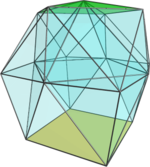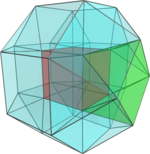CRFP4DP/Stacks (Meta, 14)
From Hi.gher. Space
Marek found that there are exactly two ways that two copies of the snubdis antiprism can be glued together at its icosahedral cell, each resulting in a CRF polychoron with 2 cubes, 12 triangular prisms, 24 square pyramids, and 16 tetrahedra.
The simplest cases of bistratic polychora are those formed by stacking two monostratic polychora such that the result is CRF. This requires:
- The two monostratic polychora have a common cell shape where the join will take place;
- The stack of two monostratic polychora is convex, that is, the sum of dichoral angles between the joining cell and the lacing cells of the respective monostratics must be ≤ 180°.
- Where the sum of dichoral angles is exactly 180°, an additional requirement is made that the result merged cell (from the combination of coplanar lacing cells) must be CRF, since there are some cases for which this is not true, such as joining together a square pyramid and a tetrahedron, which produces a sheared triangular prism with rhombus faces.
For example, two copies of the icosahedron-dodecahedron antiprism (icosahedron||dodecahedron) can be fitted together by their dodecahedral bases; the relative sizes of the icosahedron and dodecahedron of equal edge length ensures that the result is convex, and therefore CRF. It consists of 2 icosahedral cells, 100 tetrahedra, and 24 pentagonal pyramids. An elongated form is obtained by inserting a dodecahedral prism. Both forms have augmented and biaugmented variants. The other polyhedron-dual antiprisms do not produce convex CRFs this way, so this is a unique combination giving 6 new CRF polychora in total.
In the staurohedral family, there is the transstaurosemicupola[1], shown below with vis clipping off in the left image, and on in the right image.
There is also the gyrogeocupola and bigyrogeocupola[2] - where one, or two opposite square orthobicupolic rings have been removed from a geocupola and replaced with square gyrobicupolic rings, shown respectively left and right below:
The cells are:
- gyrogeocupola
- 1 elongated square cupola, 6 cubes, 8 triangular prisms, 4 tetrahedra, 1 square antiprism, 8 square pyramids, and 1 square cupola
- bigyrogeocupola
- 5 cubes, 2 square antiprisms, 16 square pyramids, 4 triangular prisms, 2 square cupolae, and 1 octagonal prism




